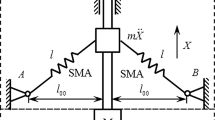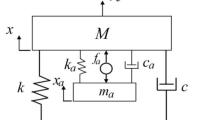Abstract
In the present paper, the optimization problem of the dynamic vibration absorbers (DVAs) for suppressing vibrations in thin plates within the wide frequency band is investigated. It is considered that the plate has simply supported edges and is subjected to a concentrated harmonic force. The vibration suppression is accomplished by the implementation of multiple mass–spring absorbers in order to minimize the plate deflection at the natural frequencies of the plate without absorbers. The governing equations of the plate equipped with DVAs for both isotropic and FG plates are derived and solved numerically and analytically. The formulation of the problem is capable of optimizing the \(L_{2}\) norm of the plate deflection at the wide frequency band with respect to mass, stiffness and position of each absorber attachment point. In this study, the possibility of simultaneous absorption of one or multiple natural frequencies of the plate without any absorbers is also studied. Some numerical results are also presented.

























Similar content being viewed by others
Abbreviations
- \(F_{{0}},F_{0}^{*}\) :
-
Dimensional and dimensionless amplitudes of excitation forcing, respectively
- \(\varOmega ,\alpha \) :
-
Dimensional and dimensionless excitation frequency, respectively
- \(t,\tau \) :
-
Dimensional and dimensionless time, respectively
- \(\left( X_{{0}},Y_{{0}} \right) ,\left( x_{{0}},y_{{0}} \right) \) :
-
Dimensional and dimensionless coordinates of applying point of the force, respectively
- \(\left( X_{j},Y_{j} \right) ,\left( x_{j},y_{j} \right) \) :
-
Dimensional and dimensionless coordinates of jth absorber attachment point, respectively
- \(\left( X,Y \right) ,\left( x,y \right) \) :
-
Dimensional and dimensionless coordinates of an arbitrary point of the plate, respectively
- \(M_{j},M_{j}^{*}\) :
-
Dimensional and dimensionless masses of jth absorber, respectively
- \(k_{j},k_{j}^{*}\) :
-
Dimensional and dimensionless stiffnesses of jth absorber, respectively
- \(u_{j},q_{j}\) :
-
Dimensional and dimensionless mass displacement of jth absorber with respect to a fixed reference point, respectively
- \(Q_{j}\) :
-
Amplitude of \(q_{j}\)
- a, b, h :
-
Length, width, and thickness of the plate, respectively
- N :
-
Number of dynamic absorbers
- \(\bar{W}\left( X,Y,t \right) ,W\left( x,y,t \right) \) :
-
Dimensional and dimensionless deflection of plate, respectively
- \(w\left( x,y \right) \) :
-
Amplitude of the dimensionless deflection of plate
- \(a_{mn}\) :
-
Coefficients of the plate mode shapes or components of \(\vec {a}\)
- E, E(z):
-
Elasticity modulus of isotropic and FG plates, respectively
- \(\nu \) :
-
Poisson’s ration
- D :
-
Flexural or bending rigidity of the plate
- \(\rho ,\rho (z)\) :
-
Density of the isotropic and FG plates, respectively
- \(\delta \left( . \right) \) :
-
Delta Dirac function
- c :
-
Wave velocity in the plate
- \(\beta \) :
-
Aspect ratio (ratio of the plate length to its width)
- \(\mu _{j}\left( \alpha \right) , \lambda _{j}\left( \alpha \right) , \tau _{lj}\left( \alpha \right) , \rho _{j}(\alpha )\) :
-
Predefined parameters
- \(\alpha _{mn}\) :
-
Dimensionless natural frequencies of the bare plate (plate without absorber)
- \(f_{mn}\left( x,y \right) , g_{mn}\left( x,y \right) , \psi \left( x,y,z,v,\alpha \right) ,\theta \left( x,y,z,v,\alpha _{rs} \right) P_{jmnpq}\left( x,y \right) ,Q_{jmnpq}\left( x,y \right) , R_{jmnpq}\left( x,y \right) ,S_{jmnpq}\left( x,y \right) \) :
-
Predefined functions
- \(A_{mnpq}\left( \alpha \right) ,B_{mnpq}\left( \alpha \right) ,B_{imnpq}\left( \alpha \right) \) ,\(C_{imnpq}\left( \alpha \right) ,D_{imnpq}\left( \alpha \right) \) :
-
Entries of matrices \({\varvec{A}}\left( \alpha \right) ,{\varvec{B}}\left( \alpha \right) ,{\varvec{B}}_{i}\left( \alpha \right) ,{\varvec{C}}_{i}\left( \alpha \right) ,{\varvec{D}}_{i}\left( \alpha \right) \)
- \(\gamma _{pq}\left( \alpha \right) \) :
-
Components of the vector \(\vec {d}\)
- \(\delta _{mp}\) :
-
Kronecker delta
- \(A_{11},B_{11},D_{11},A_{12},B_{12},D_{12},A_{33},B_{33},D_{33},I_{0},I_{1},I_{2}\) :
-
Materials constants defined for FG plate
- \(D^{*},I_{1}^{*},I_{2}^{*}\) :
-
Dimensionless parameters defined in terms of materials constants of FG plate
- \(\left\| w \right\| \) :
-
\(L_{{2}}\) norm of the plate deflection
- \(\vec {e}\) :
-
A predefined vector with components \(f_{pq}\left( x_{{0}},y_{{0}} \right) \)
- \(N_\mathrm{f}\) :
-
Number of the natural frequencies of the bare plate
- \(N_{{1}},N_{{2}}\) :
-
Numbers of indexes chosen for r and s in frequency \(\alpha _{rs}\)
- \({\varvec{J}}_{{4}N\times 4N}\) :
-
Jacobian matrix
- \(A_{j},B_{j},\theta _{{11}},\theta _{12},\theta _{22},\theta _{{01}},\theta _{02}\) :
-
Predefined constants
References
Sun, J.Q., Jolly, M.R., Norris, M.A.: Passive, adaptive and active tuned vibration absorbers—a survey. J. Mech. Des. 117, 234–242 (1995)
Ishida, Y.: Recent development of the passive vibration control method. Mech. Syst. Signal Process. 29, 2–18 (2012)
Kolovsky, M.Z.: Nonlinear Dynamics of Active and Passive Systems of Vibration Protection. Springer, Berlin (2013)
Mahadevaswamy, P., Suresh, B.S.: Optimal mass ratio of vibratory flap for vibration control of clamped rectangular plate. Ain Shams Eng. J. 7, 335–345 (2016)
Megahed, S.M., El-Razik, A.K.A.: Vibration control of two degrees of freedom system using variable inertia vibration absorbers: modeling and simulation. J. Sound Vib. 329, 4841–4865 (2010)
Tursun, M., Eşkinat, E.: H2 optimization of damped-vibration absorbers for suppressing vibrations in beams with constrained minimization. J. Vib. Acoust. 136, 21012 (2014)
Frahm, H.: Device for damping vibrations of bodies. U.S. Patent No. 989,958. U.S. Patent and Trademark Office, Washington, DC (1911)
Ormondroyd, J.: The theory of the dynamic vibration absorber. Trans. ASME Appl. Mech. 50, 9–22 (1928)
Hahnkamm, E.: The damping of the foundation vibrations at varying excitation frequency. Master Archit. 4, 192–201 (1932)
Den Hartog, J.P.: Mechanical Vibrations. Courier Corporation, North Chelmsford (1985)
Vu, X.-T., Nguyen, D.-C., Khong, D.-D., Tong, V.-C.: Closed-form solutions to the optimization of dynamic vibration absorber attached to multi-degrees-of-freedom damped linear systems under torsional excitation using the fixed-point theory. Inst. Mech. Eng. Part K J. Multi-body Dyn. 232, 237–252 (2018)
Hua, Y., Wong, W., Cheng, L.: Optimal design of a beam-based dynamic vibration absorber using fixed-points theory. J. Sound Vib. 421, 111–131 (2018)
Zhu, X., Chen, Z., Jiao, Y.: Optimizations of distributed dynamic vibration absorbers for suppressing vibrations in plates. J. Low Freq. Noise Vib. Act. Control. https://doi.org/10.1177/1461348418794563 (2018)
Kalehsar, H.E., Khodaie, N.: Optimization of response of a dynamic vibration absorber forming part of the main system by the fixed-point theory. KSCE J. Civ. Eng. 22, 2354–2361 (2018)
Noori, B., Farshidianfar, A.: Optimum design of dynamic vibration absorbers for a beam, based on H\(\infty \) and H2 optimization. Arch. Appl. Mech. 83, 1773–1787 (2013)
Nishihara, O.: Exact optimization of a three-element dynamic vibration absorber: minimization of the maximum amplitude magnification factor. J. Vib. Acoust. 141, 11001 (2019)
Cheung, Y.L., Wong, W.O.: H\(\infty \) and H2 optimizations of a dynamic vibration absorber for suppressing vibrations in plates. J. Sound Vib. 320, 29–42 (2009)
Moradi, H., Sadighi, M., Bakhtiari-Nejad, F.: Optimum design of a tuneable vibration absorber with variable position to suppress vibration of a cantilever plate. Int. J. Acoust. Vib. 16, 55 (2011)
Jacquot, R.G.: Suppression of random vibration in plates using vibration absorbers. J. Sound Vib. 248, 585–596 (2001)
Faal, R.T., Amiri, M.B., Pirmohammadi, A.A., Milani, A.S.: Vibration analysis of undamped, suspended multi-beam absorber systems. Meccanica 47, 1059–1078 (2012)
Yamaguchi, H.: Damping of transient vibration by a dynamic absorber. Trans. Jpn. Soc. Mech. Eng. 54, 561 (1988)
Nishihara, O., Matsuhisa, H.: Design of a dynamic vibration absorber for minimization of maximum amplitude magnification factor (derivation of algebraic exact solution). Trans. Jpn. Soc. Mech. Eng. Ser. C. 63, 3438–3445 (1997)
Esmailzadeh, E., Jalili, N.: Optimum design of vibration absorbers for structurally damped Timoshenko beams. J. Vib. Acoust. 120, 833–841 (1998)
Brown, B., Singh, T.: Minimax design of vibration absorbers for linear damped systems. J. Sound Vib. 330, 2437–2448 (2011)
Fang, J., Wang, S.-M., Wang, Q.: Optimal design of vibration absorber using minimax criterion with simplified constraints. Acta Mech. Sin. 28, 848–853 (2012)
Fang, J., Wang, Q., Wang, S., Wang, Q.: Min-max criterion to the optimal design of vibration absorber in a system with Coulomb friction and viscous damping. Nonlinear Dyn. 70, 393–400 (2012)
Anh, N.D., Nguyen, N.X.: Design of non-traditional dynamic vibration absorber for damped linear structures. Proc. Inst. Mech. Eng. Part C J. Mech. Eng. Sci. 228, 45–55 (2014)
Zilletti, M., Elliott, S.J., Rustighi, E.: Optimisation of dynamic vibration absorbers to minimise kinetic energy and maximise internal power dissipation. J. Sound Vib. 331, 4093–4100 (2012)
Yang, C., Li, D., Cheng, L.: Dynamic vibration absorbers for vibration control within a frequency band. J. Sound Vib. 330, 1582–1598 (2011)
Wang, Y.Z., Wang, K.S.: The optimal design of a dynamic absorber for an arbitrary planar structure. Appl. Acoust. 23, 85–98 (1988)
Viana, F.A.C., Kotinda, G.I., Rade, D.A., Steffen Jr., V.: Tuning dynamic vibration absorbers by using ant colony optimization. Comput. Struct. 86, 1539–1549 (2008)
Wong, W.O., Tang, S.L., Cheung, Y.L., Cheng, L.: Design of a dynamic vibration absorber for vibration isolation of beams under point or distributed loading. J. Sound Vib. 301, 898–908 (2007)
Issa, J.S.: Vibration absorbers for simply supported beams subjected to constant moving loads. Proc. Inst. Mech. Eng. Part K J. Multi-body Dyn. 226, 398–404 (2012)
Febbo, M., Vera, S.A.: Optimization of a two degree of freedom system acting as a dynamic vibration absorber. J. Vib. Acoust. 130, 11013 (2008)
Moghaddas, M., Esmailzadeh, E., Sedaghati, R., Khosravi, P.: Vibration control of Timoshenko beam traversed by moving vehicle using optimized tuned mass damper. J. Vib. Control 18, 757–773 (2012)
Kukla, S.: Frequency analysis of a rectangular plate with attached discrete systems. J. Sound Vib. 264, 225–234 (2003)
Kukla, S., Szewczyk, M.: Frequency analysis of annular plates with elastic concentric supports by Green’s function method. J. Sound Vib. 300, 387–393 (2007)
Zur, K.K.: Green’s function for frequency analysis of thin annular plates with nonlinear variable thickness. Appl. Math. Model. 40, 3601–3619 (2016)
Żur, K.K.: Quasi-Green’s function approach to free vibration analysis of elastically supported functionally graded circular plates. Compos. Struct. 183, 600–610 (2018)
Żur, K.K.: Free vibration analysis of elastically supported functionally graded annular plates via quasi-Green’s function method. Compos. Part B Eng. 144, 37–55 (2018)
Żur, K.K.: Quasi-Green’s function approach to fundamental frequency analysis of elastically supported thin circular and annular plates with elastic constraints. J. Theor. Appl. Mech. 55, 87–101 (2017)
Hou, P.-F., Chen, J.-Y.: A refined analysis for the transversely isotropic plate under tangential loads by the 3D Green’s function. Eng. Anal. Bound. Elem. 93, 10–20 (2018)
Rao, S.S.: Vibration of Continuous Systems. Wiley, New York (2007)
Baferani, A.H., Saidi, A.R., Jomehzadeh, E.: An exact solution for free vibration of thin functionally graded rectangular plates. Proc. Inst. Mech. Eng. Part C J. Mech. Eng. Sci. 225, 526–536 (2011)
Author information
Authors and Affiliations
Corresponding author
Additional information
Publisher's Note
Springer Nature remains neutral with regard to jurisdictional claims in published maps and institutional affiliations.
Appendices
Appendix A
Using the first equation of (19) for \(N=1\) we have
where \(\theta _{{11}}=\theta \left( x_{{1}},y_{{1}},x_{{1}},y_{{1}},\alpha _{rs} \right) ,\theta _{{01}}=\theta \left( x_{{0}},y_{{0}},x_{{1}},y_{{1}},\alpha _{rs} \right) \) and \(\epsilon =\mathop {\text {lim}}\limits _{\alpha {mn}\rightarrow \alpha _{rs}}\left( \alpha _{mn}^{{4}}-\alpha _{rs}^{{4}} \right) .\) Therefore for \(p=r\) and \(q=s\), the numerator is \(4F_{0}^{*}\left\{ f_{rs}\left( x_{0},y_{0} \right) +\mu _{1}\left( \alpha _{rs} \right) \left[ \theta _{01}f_{rs}\left( x_{1},y_{1} \right) -\theta _{11}f_{rs}\left( x_{0},y_{0} \right) \right] \right\} \) and the dominator \(-\mu _{1}\left( \alpha _{rs} \right) \left[ f_{rs}\left( x_{1},y_{1} \right) \right] ^{2}\) and thus we deduce that
The above coefficient is certainly bounded. Viewing Eq. (18), for \(N=2\) we also have
By splitting the singular and regular terms of the predefined function \(\psi \left( x,y,z,v,\alpha _{rs} \right) \) as \(\psi \left( x,y,z,v,\alpha _{rs} \right) =\theta \left( x,y,z,v,\alpha _{rs} \right) +\frac{f_{rs}\left( x,y \right) f_{rs}\left( z,v \right) }{\epsilon },\) the above equalities at \(\alpha =\alpha _{rs}\) are rewritten as follows
where
Substituting the above relations into the second equation of (19) results in
And finally, for \(m\rightarrow r\) and \(n\rightarrow s\) we conclude that
Again, it can be seen that the above coefficient is bounded.
Appendix B
The entries of the Jacobian matrix \({\varvec{J}}_{{4}N{\times 4}N}\)
Appendix C
The simplified entries of the Jacobian matrix \({\varvec{J}}_{{4}N\times 4N}\)
Appendix D: Flowchart specifying the methodology of computing the optimal parameters of the absorbers

Rights and permissions
About this article
Cite this article
Ari, M., Faal, R.T. Passive vibration suppression of plate using multiple optimal dynamic vibration absorbers. Arch Appl Mech 90, 235–274 (2020). https://doi.org/10.1007/s00419-019-01607-z
Received:
Accepted:
Published:
Issue Date:
DOI: https://doi.org/10.1007/s00419-019-01607-z




